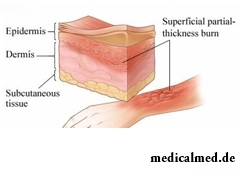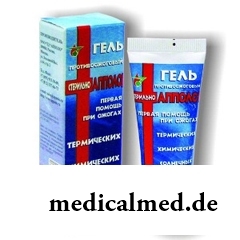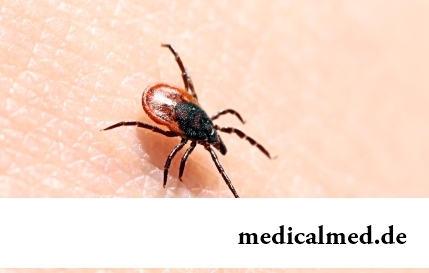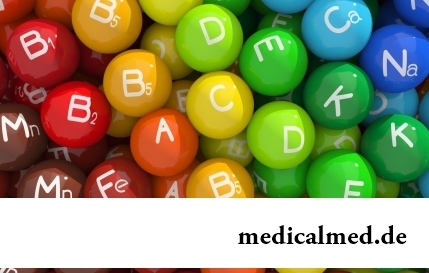





Burn
 The burn is damage of fabrics as a result of influence of excessively high temperature, electric current, radiation or the chemical agent. These injuring factors have a similar clinical picture as cause a protein denaturation. In addition to local, the burn causes the general damage to an organism, due to release and hit in blood of products of necrotic disintegration from the destroyed fabric. The general damage to an organism caused by a burn is called a burn disease. At defeat of more than 30% of a surface of skin, the amount of toxics causing damage to life-supporting systems of an organism incompatible with life comes to blood.
The burn is damage of fabrics as a result of influence of excessively high temperature, electric current, radiation or the chemical agent. These injuring factors have a similar clinical picture as cause a protein denaturation. In addition to local, the burn causes the general damage to an organism, due to release and hit in blood of products of necrotic disintegration from the destroyed fabric. The general damage to an organism caused by a burn is called a burn disease. At defeat of more than 30% of a surface of skin, the amount of toxics causing damage to life-supporting systems of an organism incompatible with life comes to blood.
Defeat of fabrics at a burn has three zones:
- necrosis zone, or a scab in the center of a burn where influence of a traumatic factor was the strongest;
- paranecrosis zone, or intermediate zone. Here normal blood circulation, and in the subsequent stops if it is not recovered, this zone can also become a necrosis zone, that is the burn wound can increase after the termination of influence of the injuring factor due to death of fabrics in a paranecrosis zone;
- hyperemia zone, on the periphery of a burn. This zone borders on the healthy fabric which is not involved in pathological process. Here fabrics are edematous and congestive.
Degrees of burns
Degrees of burns differ depending on defeat depth. Allocate four degrees of burns:
- First-degree burns, or epidermal burns. This degree of a burn assumes destruction only of a blanket of skin, epidermis. Clinically it is shown by a hyperemia (reddening) of skin, hypostasis and formation of bubbles. The bubbles of the small sizes filled with liquid light serous contents. In spite of the fact that pain can be considerable, such burns independently heal, skin is recovered completely, without formation of cicatricial fabric. The period of full healing makes one and a half-two weeks.
- Second-degree burns, or superficial thermal burns. In this case not only epidermis, but also deeper layers of skin is affected, however the zone of defeat is in derma limits. At the same time in a necrosis zone serous bubbles, however more dense, intense and extensive are also formed. The paranecrosis zone in this case is already outside a derma, in a hypodermic fatty tissue therefore at death of fabrics in this zone, the necrosis extends out of derma limits, and becomes a third-degree burn;
- Third-degree burns, or deep thermal burns. At this degree of a burn not only skin at all depth, but also its appendages, to a hypodermic fatty tissue is surprised. Bubbles of this degree of a burn are not inherent as integrity of a derma is broken, in a zone of a necrosis the scab is formed. Depth of a burn can reach a superficial muscular fascia;
- Fourth-degree burns. It is the strongest degree of a burn at which direct influence of the damaging agent affects deep body tissues: sinews, vessels, nerves, muscles, bones, joints, and sometimes and internals. At burns of the third and fourth degrees inevitably there is a burn disease, and healing of fabrics happens to formation of hems.
Feature of burns is that burn degree, especially it concerns deep or extensive damages, it is possible to establish only 48 hours later after an injury as even after removal of the damaging agent destruction of fabrics can continue.
Corrosive burn
 The corrosive burn is caused by influence of the chemical agent who reacts with body tissues, causing their destruction. The corrosive burn has some features distinguishing it from temperature or electric.
The corrosive burn is caused by influence of the chemical agent who reacts with body tissues, causing their destruction. The corrosive burn has some features distinguishing it from temperature or electric.
So, the damage rate of fabrics directly depends on concentration of chemical, degree of its activity, and also the nature of the caused reaction in fabrics. The general rule is that, as a rule, defeat of fabrics at a corrosive burn is deeper, than it seems at first sight. Each active agent at hit on skin or mucous membranes, causes reaction specific, inherent to it. And still clinical defeats at a corrosive burn can be united in two groups: acid burn and alkali burn.
The corrosive burn acid causes bystry coagulation of protein in a necrosis zone, at the same time Sukhoi a scab is formed dense, so-called. Defeat at the same time is accurately delimited from surrounding fabrics at the expense of koagulirovanny fabrics.
The corrosive burn alkali causes a kollikvatsionny necrosis. The nature of defeat at the same time such is that the dense scab is not formed, and occurs a softening, "fluidifying" of fabrics thanks to what the zone of a necrosis has no clear boundary, and the damaged fabrics "float", and the defeat zone at the same time increases. The corrosive burn alkali has less favorable current and the forecast, than a corrosive burn acid.
First aid at burns
The burn is always formed as a result of accident therefore each person has to know the principles of first-aid treatment at a burn. The help at burns has to be competent as human life sometimes depends on it.
The main thing that needs to be made, it to eliminate influence of the injuring agent. If on the person the clothes burn, it is necessary to extinguish it. At the same time burning it is impossible to run that often happens in panic as from it fire inflames only stronger, and extends up, towards the head and airways. The person needs to be laid, and to extinguish clothes, having thrown with dense fabric (a blanket, a coat, etc.) – it will block access of oxygen and the flame will go out.
First aid at a corrosive burn consists in decrease in concentration of the substance causing a burn by means of plentiful washing by water.
Further actions of the help at burns have to be directed to maintenance of life activity waiting for arrival of ambulance. It is necessary to monitor breath of the victim, and if necessary to make artificial ventilation of the lungs.
Treatment of burns
 Treatment of burns can be conservative and surgical. Tactics is defined by depth and the area of defeat.
Treatment of burns can be conservative and surgical. Tactics is defined by depth and the area of defeat.
Treatment of first-degree burns consists in the local therapy of a burn including antiinflammatory and wound healing actions. The anesthetizing drugs in the form of tablets or injections are appointed.
Treatment of second-degree burns consists in prevention of shock, the biological bandage under which apply drugs on an ointment basis is locally applied. Also treatment of a burn can be carried out by an open method.
Treatment of burns of the third and fourth degrees surgical, and operation on removal of nekrotizirovanny fabrics has to be performed as it is possible earlier to reduce hit of toxins in blood. Treatment of burns of the fourth, and sometimes and the third degree, assumes change of fabrics, for the purpose of closing of extensive fabric defect.
At any extent of defeat treatment of burns has to be urgent as without rendering the qualified help destruction of fabrics can continue also after injuring, and the continuing intake of decomposition products in blood considerably worsens a condition of the patient.
According to researches, the women drinking several glasses of beer or wine in a week have the increased risk to develop breast cancer.

Very often as a source of the infection which caused a disease serves our house - the place which a priori has to be safe. However...
Section: Articles about health
During foot walks blood moves on vessels more actively and one and all bodies are supplied with a large amount of oxygen. It affects the state of health of the person very positively....
Section: Slideshow
The popular expression "run from a heart attack" became the motto of the people supporting active lifestyle. Moreover, run became a peculiar fashionable tendency: sales of racetracks and the accompanying goods for run are at permanently high level. Whether really it is possible for one and all people and it is necessary to run to receive the portion of health, a charge of cheerfulness and good mood?...
Section: Articles about health
Each woman has preferences in the field of use of those goods which help us to look good, feel се...
Section: Articles about health
Each failure in work of bodies and systems of a human body is, as a rule, shown by the whole complex of symptoms. In particular, malfunctions with health often cause emergence of cosmetic defects in the form of rashes on a face. Experienced doctors know that локализац...
Section: Articles about health
Residents of big cities quite often have a disease which is known as the syndrome of chronic fatigue (SCF) today. This illness affects the people belonging to various social and demographic groups and living on all continents. Most of all SHU are subject women aged from 25 up to 45 years. Statistically, the number of cases fluctuates in the different countries from 10 to 37 people on 100 thousand, but specialists believe that these figures are significantly underestimated as people, страдающ...
Section: Articles about health
Sometimes it seems that modern society was divided into two camps: representatives of the first are sure that has to for contraception отвеч...
Section: Articles about health
Tick-borne encephalitis – one of the most dangerous viral diseases which causative agents transfer and is given to people by ixodic mites. These are the small blood-sicking insects living in the considerable territory of our country. The person bitten by a tick can catch...
Section: Articles about health
Each person knows that fervescence is an illness sign. However too low temperature (hypothermia), especially also can demonstrate existence of diseases when it is observed long enough. Such state is dangerous that it, unlike fever, does not give a serious inconvenience: patients usually complain only of weakness, drowsiness, apathy. Sometimes the fever and a cryesthesia in extremities joins. Many people at similar symptoms...
Section: Articles about health
On the head of the person about one million hair follicles, or as they are called still, hair bulbs are located. At the moment he is born...
Section: Articles about health
Good appetite was always considered as a sign of good health. The correct operation of the mechanism which is responsible for the need for nutrients and receiving pleasure from process of its satisfaction demonstrates that the organism functions without special from...
Section: Articles about health
The phenomenon of improvement of a condition of the patients at administration of drugs who are not containing active agents, so-called effect of placebo is known long ago. At the end of the 18th century the American doctor Perkins began to treat people the "miracle" sticks made of alloy of steel and brass. Was for several minutes to press such subject enough to a sore point that it became much easier for the patient. Having suspected Perkins of charlatanism, his colleagues tried to repeat "miracle" by means of sticks, steles...
Section: Articles about health
Many of us, probably, noticed more than once that from intellectual loadings at some point the brain as though "overheats" also "assimilation"...
Section: Articles about health
What they, women? Beautiful, gentle, passionate and at the same time windy, gusty, and nervous. And what is stranger: have all these qualities of the woman at the same time. But here only the mood their time sharply changes on completely opposite: in the morning...
Section: Articles about health
Summer in the heat. Many are going to spend vacation abroad. Travelers the tender seas, rest on beaches wait, for sightseeing, campaigns on natural and cultural reserves. But, unfortunately, on vacation also problems with health can wait for us. On a foreign trip it is possible to face also diseases which not only will spoil long-awaited issue, but also will force to be treated within long months after its termination. To be insured completely from troubles of it a sort...
Section: Articles about health
Vitamin complexes belong to the most popular drugs, probably, in our country there is no person who was not hearing about a floor...
Section: Articles about health
According to data of World Health Organization, the cataract is diagnosed almost for 7% of the population of Earth. The statistics of incidence is considered not full as at an initial stage the illness, as a rule, does not cause to the person of special inconveniences, and many having got sick...
Section: Articles about health
It is difficult to revaluate importance of kidneys for an organism. These bodies not only perform work on purification of blood of decomposition products and removal of excess liquid. They are responsible also for production of some hormones necessary for maintenance of a normality of a bone tissue, and also for a producing red blood cells – erythrocytes....
Section: Articles about health
Life expectancy in various regions of Earth is not identical. Exert impact on it social stability, economic бл...
Section: Articles about health
It is known that the person for 80% consists of water which participates in all processes of an organism. The person loses liquid daily – as a result of sweating, breath, an urination, and its insufficient completion due to various reasons can bring to обезвожив...
Section: Articles about health
Bees – really unique beings. Practically all products of their life activity are used by the person. Since the most ancient times medicinal properties of honey and other substances received in the course of beekeeping are known. The fact that all these products are recognized not only national, but also official medicine is especially significant. About influence and routes of administration of bee "drugs" the speech in this article will also go....
Section: Articles about health
Not without reason doctors say that 90% of diseases begin or develop because of misoperation of intestines. Disturbance of its functions связ...
Section: Articles about health
Several decades ago the basil (the district khan, реан, Reagan) was considered as a part of the Caucasian or east cuisine, but today it strongly took the place on tables of Russians. Greens of this plant possess a strong, pleasant smell and specific fresh taste, because of to...
Section: Articles about health
Olive oil – the product capable to make a powerful contribution to health of the person if it includes it in the diet. The rich vitamin composition of oil does it by a product number one from many diseases including from deadly. Only two tablespoons of oil from olives in day prevent emergence of diseases of vessels and heart, cancer, problems with digestion, presenilation, a depression and many other illnesses which treatment would demand a lot of time and forces. Let's consider on...
Section: Articles about health
Condition of lips (their morbidity, outward) – one of indicators of health of the person. Peeling, dryness, pallor, and also трещ...
Section: Articles about health
With age in a human body harmful substances collect. We receive them with food and water, at inhalation of the contaminated air, reception of medicines, use of household chemicals and cosmetics. A considerable part of toxins accumulates in a liver, osnovno...
Section: Articles about health
The person, as well as all other beings living on our planet feels weather changing. It is the normal meteosensitivity which is not causing to healthy people of special troubles. Meteodependence, on the contrary, is the morbid condition which is characterized by an exacerbation of chronic illnesses at change of air temperature, differences of atmospheric pressure, wind strengthening, magnetic storms and other "surprises" on which the nature is so generous. The people suffering from meteodependence have to з...
Section: Articles about health
